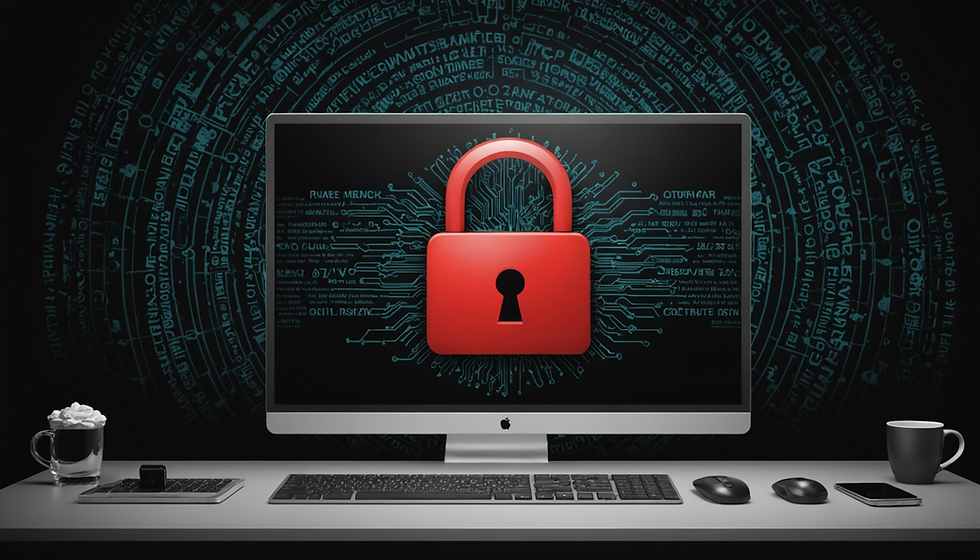Understanding Ransomware: Protecting Your Business from a Growing Threat
- guelerbasolkorkmaz
- Jan 22
- 4 min read
In recent years, ransomware attacks have become one of the most prevalent and damaging cybersecurity threats faced by organizations of all sizes. Whether it’s a small business or a large enterprise, the devastating impact of a ransomware attack can lead to data loss, operational disruption, and significant financial costs. In this article, we’ll dive into what ransomware is, how it works, and most importantly, how you can protect your organization from this growing threat.
What is Ransomware?
Ransomware is a type of malicious software (malware) designed to block access to a computer system or its data until a ransom is paid. Once the malware infects a system, it encrypts files, rendering them inaccessible to users. The attackers then demand payment, typically in cryptocurrency, in exchange for a decryption key to restore access to the files.
There are various types of ransomware, but the two most common are encrypting ransomware and locker ransomware:
Encrypting ransomware: The most common form, which encrypts files on the victim's system, making them inaccessible without the decryption key.
Locker ransomware: Instead of encrypting files, this type locks the victim out of their system entirely, preventing access to any files or applications.
While paying the ransom may seem like an easy solution, there's no guarantee the attackers will follow through with their promise to decrypt the files, and paying only encourages the criminal activity.
The Rising Threat of Ransomware
Ransomware has evolved from being a sporadic nuisance to a widespread, sophisticated threat affecting organizations globally. According to recent reports, ransomware attacks increased by 150% in 2021 alone, with hackers targeting industries such as healthcare, manufacturing, and finance. What’s even more concerning is the rise of double extortion tactics, where cybercriminals not only encrypt data but also threaten to release sensitive information to the public unless a ransom is paid.
Cybercriminals are becoming more advanced in their methods, using phishing emails, malicious attachments, and exploiting vulnerabilities in outdated software to infiltrate systems. With remote work and cloud services on the rise, attack surfaces are expanding, making it harder for organizations to defend against this evolving threat.
The Cost of Ransomware
The cost of a ransomware attack can be devastating, both financially and operationally. Aside from the ransom payment itself (which can range from hundreds to millions of dollars), companies also face costs associated with:
System downtime: The time it takes to restore systems and services can lead to significant losses in productivity.
Data loss: If data isn’t backed up or can’t be recovered, it may be permanently lost, leading to severe disruptions.
Reputation damage: Customers and partners may lose trust in a company that has been compromised, which can result in long-term reputational harm.
Legal and regulatory penalties: Depending on the nature of the data involved, organizations may face compliance issues and legal consequences for failing to protect sensitive information.
How to Protect Your Organization from Ransomware
While the threat of ransomware is growing, there are proactive steps you can take to protect your organization and minimize the risk of an attack. Here are some best practices to safeguard your business:
1. Regular Backups
Regularly back up your critical data and ensure it’s stored securely and offline. In the event of a ransomware attack, you can restore your systems without having to pay the ransom.
2. Keep Software Up-to-Date
Regularly update operating systems, software, and applications to patch known vulnerabilities. Cybercriminals often exploit outdated software to gain access to systems.
3. Implement a Zero Trust Security Model
Adopt a Zero Trust approach to security, assuming that no one—whether inside or outside the network—can be trusted by default. This strategy involves stringent access controls, network segmentation, and continuous monitoring.
4. Train Employees
The majority of ransomware attacks begin with phishing emails. Provide regular training to employees on how to spot suspicious emails, avoid clicking on unknown links, and report any suspicious activity to IT.
5. Use Multi-Factor Authentication (MFA)
Implement MFA across your organization to add an extra layer of security. Even if attackers gain access to a password, MFA can prevent unauthorized access to sensitive systems.
6. Segment Your Network
Divide your network into segments to limit the spread of ransomware in the event of an infection. This can contain the attack to one part of the network, minimizing damage to the rest of your systems.
7. Invest in Robust Cybersecurity Solutions
Ensure you have advanced endpoint protection, firewalls, and intrusion detection systems in place. Having real-time monitoring and detection tools can help identify potential ransomware threats early.
8. Develop an Incident Response Plan
Be prepared with a comprehensive incident response plan that outlines how to respond to a ransomware attack. This plan should include communication protocols, roles and responsibilities, and steps for containing and recovering from the attack.
What to Do If You’re Attacked
If you find yourself the victim of a ransomware attack, it’s critical to act quickly. First, disconnect affected systems from the network to prevent further spread. Contact a cybersecurity professional to help with the incident response and recovery process. Additionally, report the attack to law enforcement and any relevant regulatory bodies.
While paying the ransom may seem like a quick fix, it’s never recommended. Instead, work with experts to try to recover data through legitimate means.
Conclusion
Ransomware is a serious threat that can cause significant financial, operational, and reputational harm to your business. However, by taking proactive steps to strengthen your cybersecurity defenses, educate your employees, and develop a strong incident response plan, you can reduce your risk and ensure that your organization is prepared to handle potential threats.
Stay vigilant, stay informed, and remember that prevention is always better than cure when it comes to cybersecurity.

Comments